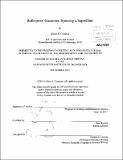| dc.contributor.advisor | Russ Rymer. | en_US |
| dc.contributor.author | Conahan, Gillian S | en_US |
| dc.contributor.other | Massachusetts Institute of Technology. Graduate Program in Science Writing. | en_US |
| dc.date.accessioned | 2012-01-12T19:30:33Z | |
| dc.date.available | 2012-01-12T19:30:33Z | |
| dc.date.copyright | 2011 | en_US |
| dc.date.issued | 2011 | en_US |
| dc.identifier.uri | http://hdl.handle.net/1721.1/68474 | |
| dc.description | Thesis (S.M. in Science Writing)--Massachusetts Institute of Technology, Dept. of Humanities, Graduate Program in Science Writing, 2011. | en_US |
| dc.description | Cataloged from PDF version of thesis. | en_US |
| dc.description | Includes bibliographical references (p. 34). | en_US |
| dc.description.abstract | Spider silk is a material of extraordinary beauty and utility. From the spider's perspective, it is foremost a building material, but also a safety net, a sensory organ, a weapon. From a human perspective, it is a material of extraordinary mechanical properties, an object of artistic and cultural interest, and a valuable window into the evolutionary history of spiders. Historically, there have been a mere handful of spider silk textiles, the most recent example of which was constructed by Simon Peers and Nicholas Godley. This was an extravagant work of art, and the silk was collected entirely by hand. Though the finished article is a testament to the beauty of spider silk, it also illustrates the technical challenges associated with obtaining it in any significant quantity. The effects of this scarcity are evident in the lab of David Kaplan at Tufts University. His group has developed a wide variety of applications for silk, but has focused mainly on silkworm silk in spite of spider silk's greater variety and superior mechanical properties. In the wild, spiders use silk for everything from weaving webs and capturing prey to breathing underwater. Shaped by almost every environment on Earth, spider silk has evolved into endless variations and permutations, offering a vast wealth of material knowledge if we can find a way to tap it. A visit to Cheryl Hayashi's spider silk genetics lab at the University of California, Riverside offers a look inside a spider and a glimpse of how genetic research can illuminate the evolution of silk. At the same time, it puts the limits of our knowledge into stark relief. The scarcity of natural spider silk has helped to drive a small industry in bioengineered and synthetic silk research, and also motivated projects that seek to apply the structural principles of silk fibers to other materials. But so far, these efforts are only a pale imitation of the real thing. For now, the spider is keeping her secrets. | en_US |
| dc.description.statementofresponsibility | by Gillian S. Conahan. | en_US |
| dc.format.extent | 35 p. | en_US |
| dc.language.iso | eng | en_US |
| dc.publisher | Massachusetts Institute of Technology | en_US |
| dc.rights | M.I.T. theses are protected by
copyright. They may be viewed from this source for any purpose, but
reproduction or distribution in any format is prohibited without written
permission. See provided URL for inquiries about permission. | en_US |
| dc.rights.uri | http://dspace.mit.edu/handle/1721.1/7582 | en_US |
| dc.subject | Graduate Program in Science Writing. | en_US |
| dc.title | Bulletproof gossamer : spinning a superfiber | en_US |
| dc.title.alternative | Spinning a superfiber | en_US |
| dc.type | Thesis | en_US |
| dc.description.degree | S.M.in Science Writing | en_US |
| dc.contributor.department | Massachusetts Institute of Technology. Graduate Program in Science Writing | en_US |
| dc.contributor.department | MIT Program in Writing & Humanistic Studies | |
| dc.identifier.oclc | 769911187 | en_US |
